To correctly size your water softener, we need to follow a simple formula: multiply your household members by 75 gallons/day, convert your water hardness from mg/L to GPG (divide by 17.1), add 5 GPG for each ppm of iron, then calculate grains/day (people × daily gallons × GPG). Don’t forget to adjust for system efficiency (75-85%) and accommodate peak flow rates. Proper sizing ensures weekly regeneration cycles, maximizing resin lifespan while preventing wasteful salt consumption.
Key Takeaways
- Calculate daily softening needs by multiplying household members × 75 gallons × hardness level in GPG.
- Test your water’s hardness level using colorimetric kits or professional lab analysis for accurate sizing.
- Size systems for peak flow rates to prevent pressure drops when multiple fixtures run simultaneously.
- Factor in iron content by adding 5 GPG to your hardness calculation for each 1 ppm of iron.
- Choose a softener capacity that allows for weekly regeneration to maximize resin lifespan and efficiency.
Water Hardness: Understanding Your Starting Point
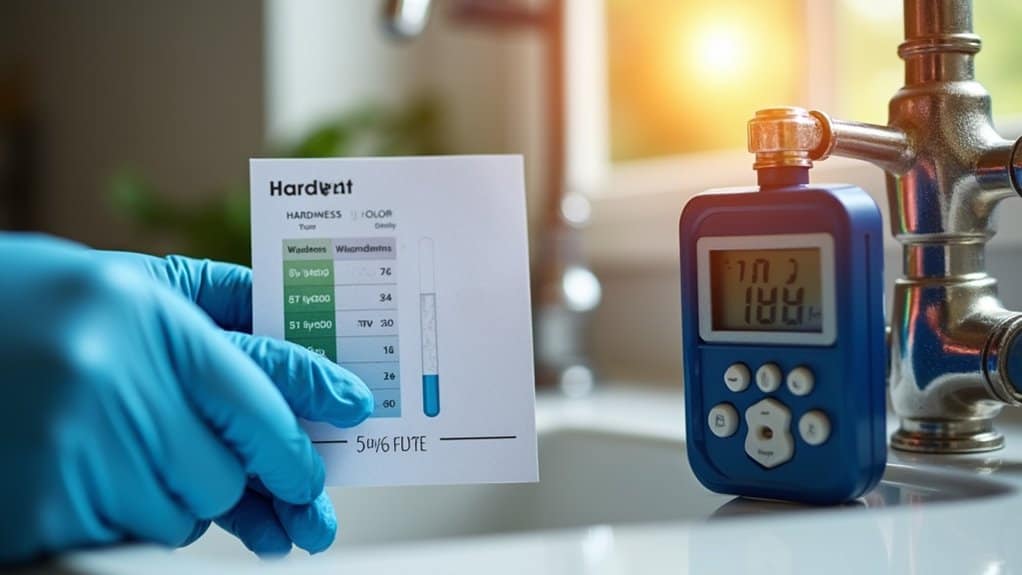
Water hardness serves as the fundamental parameter for sizing a water softener system correctly. We measure hardness using several classification systems, including mg/L of CaCO₃, grains per gallon (gpg), French degrees (°f), or German degrees (°dH).
For accurate sizing, we recommend using home test kits with colorimetric indicators or digital titrators rather than test strips, which lack precision. Independent laboratories can provide highly accurate results if you need professional analysis for complex water treatment systems. Additionally, relying solely on hardness tests can be misleading, as water softener sizing requires a comprehensive assessment of various water quality factors.
When measuring, determine if your hardness is temporary (carbonate) or permanent (non-carbonate) by comparing alkalinity levels to total hardness.
Calculating Daily Softening Requirements For Your Home
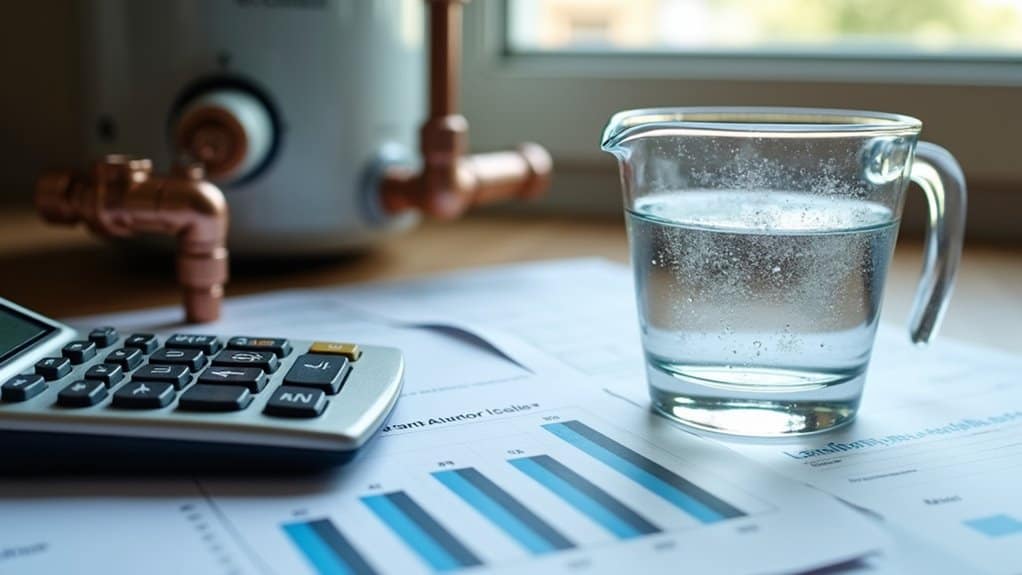
Three critical calculations establish the foundation for proper water softener sizing: daily water consumption, hardness level conversion, and total grain removal requirements.
We’ll show you how to determine exactly what your household needs.
- Multiply household members by 75 gallons/day for basic consumption estimates
- Convert water hardness from mg/L to GPG by dividing by 17.1
- Add 5 GPG to hardness for every 1.0 ppm of iron present
- Calculate daily requirement: (people × daily gallons × GPG) = grains/day
- Adjust final calculations to account for system efficiency (75-85%)
Improper sizing can result in excessive salt consumption and higher operating costs over the life of your system, leading to significant cost savings if sized correctly.
Aim for weekly regeneration cycles to optimize resin performance and salt efficiency.
How To Select The Right Water Softener Capacity
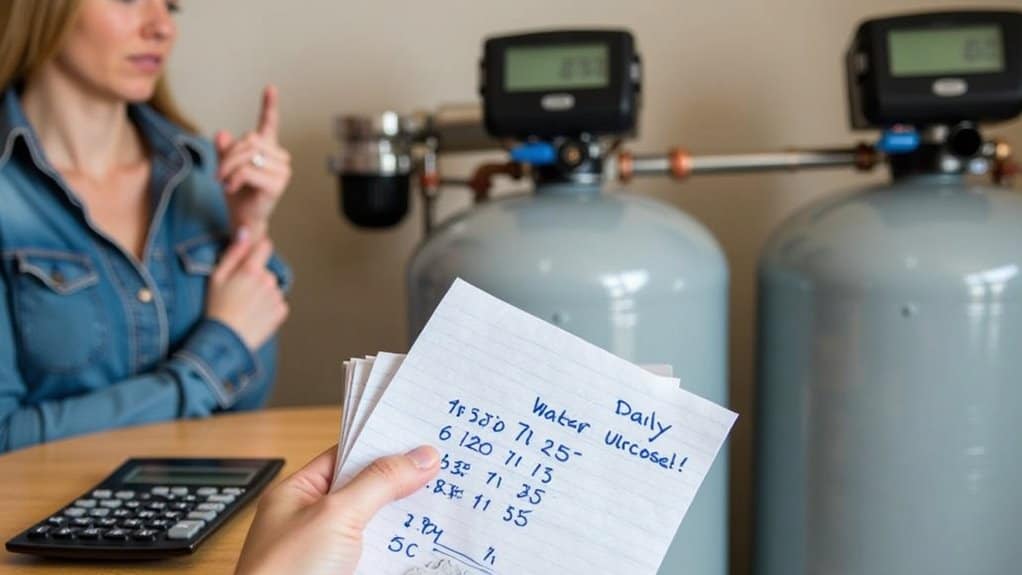
Now that you’ve calculated your daily softening requirements, selecting the appropriate water softener capacity becomes your next critical decision.
We recommend choosing a system that handles your peak flow rates (measured in GPM) while accommodating your household’s hardness level.
For optimal performance, your softener should manage simultaneous fixture usage without pressure drops.
Consider both GPG measurements and contaminant levels—especially iron and manganese, which can reduce resin efficiency. Larger softener units are necessary for water with high metal content to ensure effective filtration and prevent damage to your plumbing system.
Don’t forget to factor in seasonal variations and future needs.
High-efficiency systems may offer lower salt consumption but sometimes sacrifice capacity.
When possible, consult with local water experts for region-specific recommendations.
Common Sizing Mistakes And How To Avoid Them
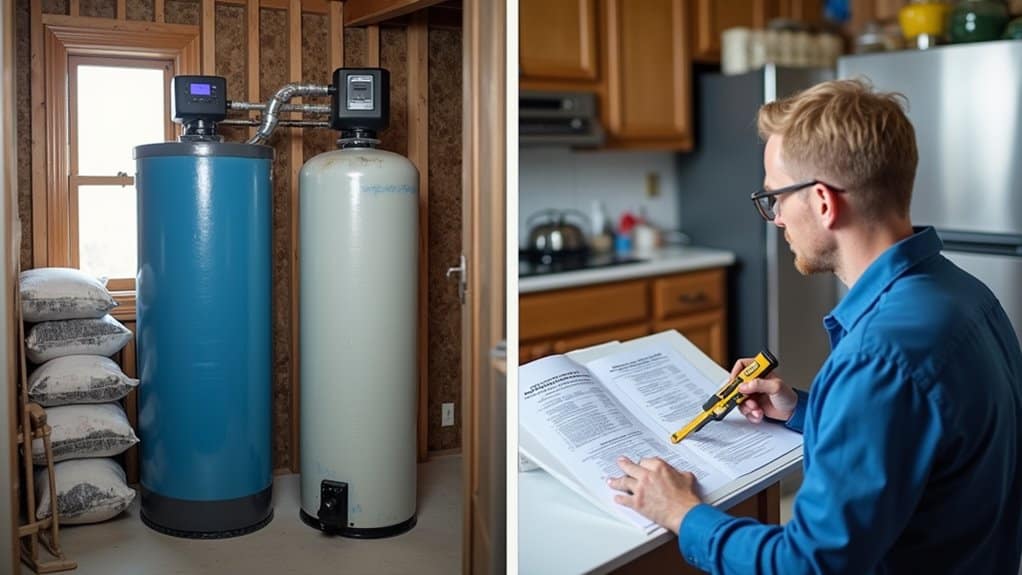
Despite careful calculation, many homeowners fall victim to common sizing errors that compromise their water softener’s performance and longevity.
We’ve identified these critical mistakes to help you avoid costly system inefficiencies:
- Underestimating household demand by calculating only average usage without accounting for peak periods
- Selecting units based on labeled capacity claims rather than actual cubic feet of resin
- Miscalculating grain requirements by not multiplying daily water consumption by hardness level
- Ignoring resin type compatibility with your specific water chemistry, which can lead to performance issues during operation
- Overlooking regeneration frequency settings that balance water and salt efficiency
Undersized systems regenerate too frequently, reducing resin lifespan, while oversized units risk channeling and ineffective regeneration. Properly sized systems will effectively replace calcium and magnesium with sodium ions during the ion exchange process.
Always verify flow rates match your plumbing infrastructure.
Frequently Asked Questions
When Should I Replace the Resin in My Water Softener?
We recommend replacing water softener resin when you notice hard water symptoms returning, strange deposits appear, water quality declines, or flow rates decrease—typically every 8-10 years with normal use.
Can I Install a Water Softener Myself or Need Professional Help?
We recommend DIY installation if you have basic plumbing skills, soldering experience, and can manage 150-pound tanks. Without these capabilities, professional installation prevents costly water damage and system failures.
How Do Vacation Homes Affect Water Softener Sizing Calculations?
We’ll size vacation home softeners for maximum occupancy periods, not average use. We’ll apply buffer multipliers of 1.25-1.5 to accommodate irregular regeneration cycles and unpredictable water usage patterns.
Will a Water Softener Remove Other Contaminants Besides Hardness Minerals?
No, we don’t recommend relying on water softeners for contaminant removal. They’re designed exclusively for hardness minerals through ion exchange, leaving pathogens, PFAS, heavy metals, and organics completely untreated.
How Does Water Pressure Affect Water Softener Performance and Sizing?
We need adequate water pressure for effective distribution through resin beds. Low pressure inhibits proper resin contact, while high flow rates require larger units to prevent pressure drops during regeneration cycles.
Conclusion
We’ve presented the essential methodology for precisely sizing your water softener system. By analyzing water hardness, calculating your household’s specific daily demands, selecting appropriate grain capacity, and avoiding common dimensioning errors, you’ll achieve optimal performance and efficiency. Remember, undersized units regenerate excessively while oversized systems waste resources. This systematic approach eliminates guesswork—ensuring you’ll invest in the correctly specified solution for your water treatment needs.

Craig “The Water Guy” Phillips is the founder of Quality Water Treatment (QWT) and creator of SoftPro Water Systems.
With over 30 years of experience, Craig has transformed the water treatment industry through his commitment to honest solutions, innovative technology, and customer education.
Known for rejecting high-pressure sales tactics in favor of a consultative approach, Craig leads a family-owned business that serves thousands of households nationwide.
Craig continues to drive innovation in water treatment while maintaining his mission of “transforming water for the betterment of humanity” through transparent pricing, comprehensive customer support, and genuine expertise.
When not developing new water treatment solutions, Craig creates educational content to help homeowners make informed decisions about their water quality.


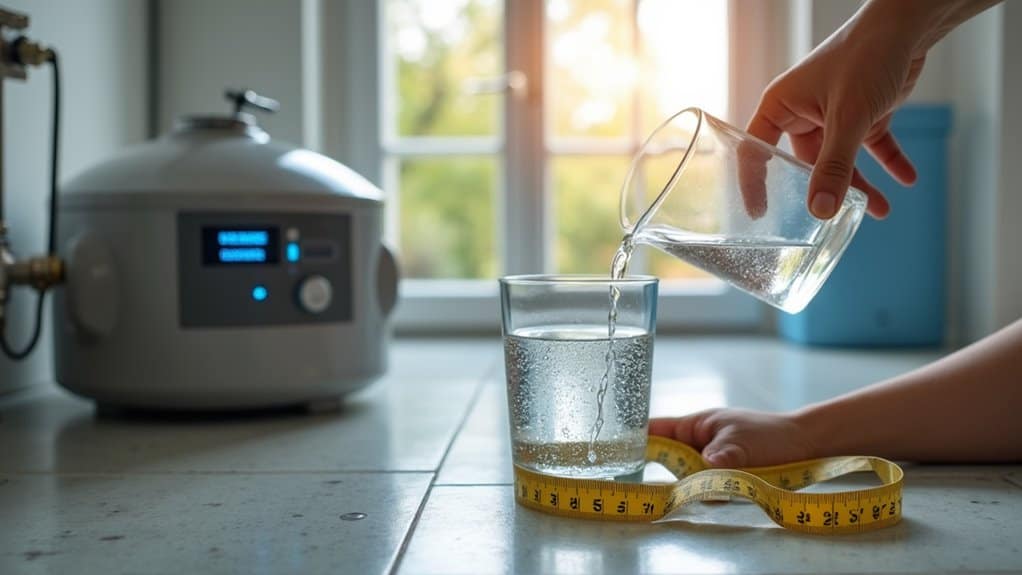
Coming from my investigation, shopping for consumer electronics online can for sure be expensive, but there are some guidelines that you can use to obtain the best deals. There are continually ways to find discount discounts that could make one to buy the best technology products at the smallest prices. Thanks for your blog post.